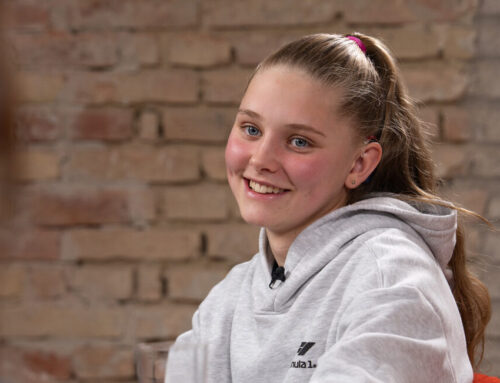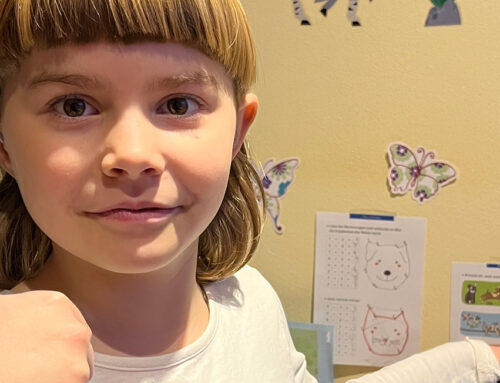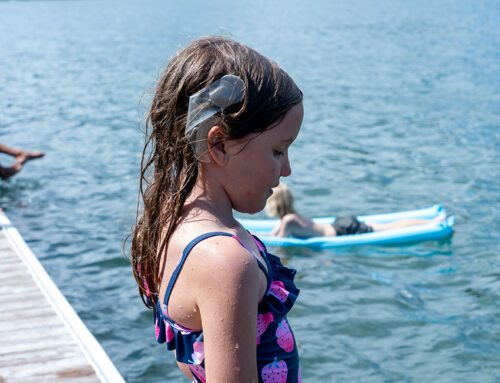At work with BONEBRIDGE
“I like to tell people about it”, Natalie Faist is always pleased about interest in her BONEBRIDGE bone conduction implant. This kindergarten teacher is really sensitive to the topic of hearing problems in her pupils, as she herself is hearing impaired on one side and got implanted as a teenager.

The children of the tree group in the Hollenegg kindergarten are sitting in the morning circle. A girl with blond pigtails is sitting in the center of the circle with her eyes closed. Into the silence, a firm “beep, beep” rings out from somewhere in the circle. Elementary teacher Nathalie Faist and her colleague are playing a game “Birdie, how do you beep?” with the children of the local kindergarten. The girl with the blond pigtails and closed eyes is asked to guess the direction from which “the little bird” beeped.
“Without my button, I would have a hard time with a task like this” admits a 26-year-old kindergarten teacher. She refers to the audio-processor of her implant system as a button. Natalie was born with atresia in her right ear: her right auricle is much smaller than her left one. The ossicles in the right middle ear are also tiny and the external ear canal is not developed. As a result, she has only 20 to 25 percent hearing on the right side – a single-sided hearing loss that is difficult to compensate for with conventional hearing aids.
A hearing solution – also for young people
As a result of her atresia of the auditory canal, Nathalie had poor perception and could barely understand when spoken to from the right side. “I always made sure that people who talk to me stand on my left side. It was also difficult for her to understand in a noisy environment – which is why she always sat in front of the teacher at school.
“My doctor at the time said: There is nothing you can do”, she says shrugging her shoulders. But she couldn’t have imagined wearing a conventional hearing aid at the time. She explains why: “I couldn´t have associated a hearing aid with a teenager. With my button, it’s different.”
She received her “button” 10 years ago. That was when the 16-year-old first came with her parents to Dr. Alexander Gotschuli’s ENT practice in Deutschlandsberg. He recognized the problem and suggested a bone conduction hearing implant.
“In August, I celebrated my hearing anniversary”
The family went to Innsbruck University Hospital and felt “warmly welcome” from the very first moment, as the BONEBRIDGE user describes in retrospect. “There was a lot to be done,” she recalls of her parents’ quick decision. At the time, she had no serious objections and today, she is actually very happy. “It was the right and important decision for me. It makes a big difference for me to listen with the BONEBRIDGE. I can´t imagine doing without it.” She hears better, has to strain less when listening and can assess her own pronunciation better now.
At the time, she had an Amadé as an outside audio processor, which shape is not really reminiscent of a button. Initially, Natalie hid it under the hair, together with her unusually small auricle. “Now I don’t really care about it. It is part of me.” Today, she only takes her audio processor off occasionally, when she´s home alone. Then it suddenly gets quiet on the right side: “I can tell the difference right away.”
BONEBRIDGE provides security in the local community
In the wine region Schilcherland where Natalie grew up, blossoms a lively community life. More than 30 organizations are registered in the market town, together with a fire-department and several choirs and bands.
Natalie Faist has been socially active since her early age: she began playing the flute at the age of eight and has been a member of the local music band since her teenage years. They accompanied many church occasions and folk festivals: “When we march, my perception would not be so good without BONEBRIDGE. I wouldn’t be as confident in playing music either.”
At first, the additional hearing impression with the implant when playing music was quite unfamiliar. As part of the powerful-sounding brass band, it sometimes became uncomfortably loud for her. “I received three different hearing programs. There was also a particularly quiet one for rehearsals, which was just loud enough that I could stand it.” Today, she doesn’t necessarily need that anymore: “At some point, you just forget to switch.”
“I couldn’t work in kindergarten without BONEBRIDGE”
BONEBRIDGE accompanies her from the moment when she wakes up until she goes to bed. She only takes the processor off for swimming or when she makes herself comfortable on the couch. “But without my button, I certainly couldn´t go to kindergarten in the morning!” She says that she always realizes how important her hearing implant is in her daily life with children when she has to remove it to change a battery. “I love my job, but it is also quite demanding. Without BONEBRIDGE, or without good hearing on both sides – it would be very, very tiring for me.”
When she chose her career and started with her education, at the time 14-year-old did not take her hearing limitations into account. “Without BONEBRIDGE, it all would have been a challenge,” she smiles in retrospect. Many situations could have become a challenge without an implant. Or to guess the direction of a sound in a game in a sitting circle with her eyes closed: that would have been very difficult too.
The pre-school teacher is particularly sensitive to when one of her protégés has difficulty perceiving or classifying certain sound characteristics. One of her pupils also uses hearing aids. “At the moment, I’m the first contact person in the house, because I can empathize with her particularly well.”






